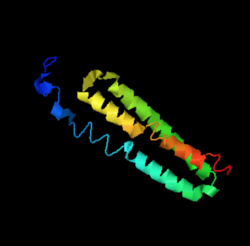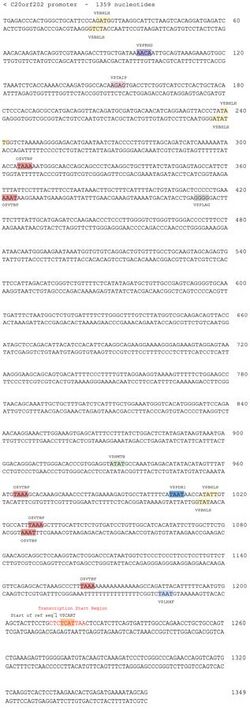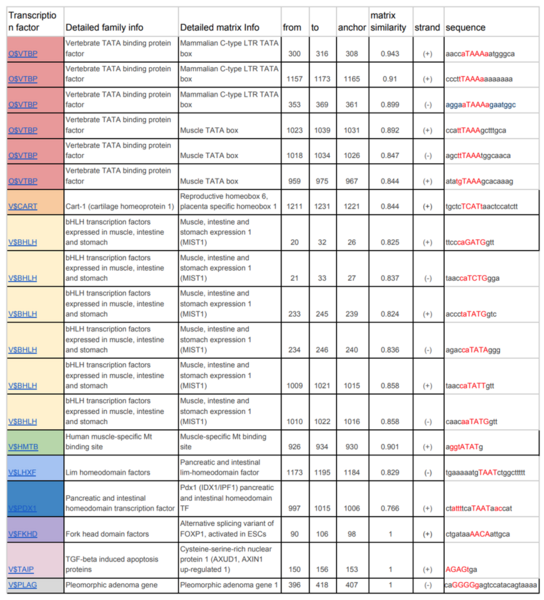Biology:C20orf202
| C20orf202 | |
|---|---|
| File:Ideogram human chromosome 20.svg Chromosome 20 | |
| Identifiers | |
| Symbol | C20orf202 |
| NCBI gene | 400831 |
| HGNC | 37254 |
| RefSeq | NM_001009612.3 |
| UniProt | A1L168 |
C20orf202 (chromosome 20 open reading frame 202) is a protein that in humans is encoded by the C20orf202 gene. In humans, this gene encodes for a nuclear protein that is primarily expressed in the lung and placenta.[1]
Gene
C20orf202 is located on the plus strand of chromosome 20 at 20p13.[2] The gene is 4,826 base pairs long. It spans from chr20:1,184,098-1,188,918, and contains 2 exons.[3]
Transcript
There is one transcript of C20orf202. The mRNA sequence is 1,609 base pairs long.[4]
Protein
The protein encoded by C20orf202 is 122 amino acids in length with a predicted molecular mass of 13591 Da and a predicted isoelectric point of 9.13 pl/MW.[5][6] C20orf202 contains PFAM domain DUF3461 at amino acids 3-67.[7] This domain codes for a protein of unknown function. The structure of C20orf202 consists of 46.72% random coils, 42.62% alpha helixes, and 10.66% extended strands.[8]

Regulation
Gene level regulation
The C20orf202 promoter has many transcription factor binding sites, most notably at the beginning and end of the promoter. These sites are shown in the figure to the right and are listed below with their respective functions.[10]
Transcript level regulation
MicroRNA binding sites are only found in the 3' UTR of C20orf202. Most of these sites are found in the beginning or end of the 3' UTR, with many located in close proximity to each other.[11] These 3' UTR microRNA binding sites can be seen in the figure to the right.
Protein level regulation
C20orf202 has many phosphorylation and glycosylation sites throughout the protein.[12][13] A few of the phosphorylation sites are located in highly conserved regions of the protein.
Expression
In humans, C20orf202 has moderate mRNA abundance across cells types, though higher than average expression in the kidney and heart, it is not significantly so.[14] Additionally C20orf202 expression increases during fetal development of kidney, lung, and intestinal tissues.[15]

Homology
Paralogs
C20orf202 has three known paralogs- FAM167a, FAM167b, and AARD.[17]

Orthologs
C20orf202 orthologs can be found in major groups such as mammals, reptiles, amphibians, and distantly fish.
This table lists several orthologs for C20orf202 including genus and species, common name, taxonomic group, evolutionary date of divergence, accession number, sequence length, sequence identity, and sequence similarity.
| Genus and species | Common name | Taxonomic group | Estimated date of divergence | Accession number | Length (amino acids) | Sequence identity | Sequence similarity |
|---|---|---|---|---|---|---|---|
| Homo sapiens | Human | Mammalia (Primata) | 0 | NP_001009612.1 | 122 | 100% | 100% |
| Pan troglodytes | Chimpanzee | Mammalia (Primata) | 6.7 | XP_001167776.1 | 122 | 99% | 99% |
| Dipodomys ordii | Ord's kangaroo rat | Mammalia (Rodentia) | 90 | XP_012866108.1 | 151 | 74% | 87% |
| Peromyscus maniculatus | Deer mouse | Mammalia (Rodentia) | 90 | XP_006985608.1 | 192 | 68% | 81% |
| Fukomys damarensis | Damaraland mole-rat | Mammalia (Rodentia) | 90 | XP_010611217.1 | 131 | 67% | 77% |
| Grammomys surdaster | African woodland thicket rat | Mammalia (Rodentia) | 90 | XP_028630806.1 | 190 | 60% | 71% |
| Sus scrofa | Wild boar | Mammalia (Artiodactyla) | 96 | XP_013840663.1 | 123 | 84% | 90% |
| Monodon monoceros | Narwhal | Mammalia (Artiodactyla) | 96 | XP_029077716.1 | 153 | 79% | 90% |
| Delphinapterus leucas | Beluga whale | Mammalia (Artiodactyla) | 96 | XP_022448507.1 | 153 | 79% | 90% |
| Orcinus orca | Orca | Mammalia (Artiodactyla) | 96 | XP_004273009.1 | 136 | 78% | 90% |
| Eptesicus fuscus | Big brown bat | Mammalia (Chiroptera) | 96 | XP_028000906.1 | 179 | 79% | 88% |
| Vulpes vulpes | Red fox | Mammalia (Carnivora) | 96 | XP_025841919.1 | 163 | 79% | 88% |
| Canis lupus familiaris | Dog | Mammalia (Carnivora) | 96 | XP_022265199.1 | 125 | 77% | 87% |
| Lacerta agilis | Sand lizard | Reptilia (Squamata) | 312 | XP_033006940.1 | 95 | 47% | 64% |
| Podarcis muralis | Common wall lizard | Reptilia (Squamata) | 312 | XP_028591365.1 | 95 | 45% | 58% |
| Chelonoidis abingdonii | Pinta Island tortoise | Reptilia (Testudines) | 312 | XP_032622241.1 | 98 | 46% | 61% |
| Alligator sinensis | Chinese alligator | Reptilia (Crocodilia) | 312 | XP_006030613.1 | 98 | 42% | 59% |
| Nanorana parkeri | High Himalaya frog | Amphibia (Anura) | 351.8 | XP_018411922.1 | 114 | 44% | 58% |
| Cyprinodon variegatus | Sheepshead minnow | Actinopterygii (Cyprinodontiformes) | 435 | XP_015232405.1 | 146 | 54% | 72% |
| Cyprinus carpio | Common carp | Actinopterygii (Cyprinodontiformes) | 435 | KTF83963.1 | 190 | 47% | 68% |
Interacting proteins
Two hybrid prey pooling followed by two hybrid array revealed that C20orf202 is predicted to interact with two other proteins: SNAPAP and HNRNPCL1.[19] SNAPAP (SNARE-associated protein) has a role in the SNARE binding complex, and is also associated with Hermansky–Pudlak syndrome and tricuspid valve stenosis.[20] HNRNPCL1 (Heterogeneous Nuclear Ribonucleoprotein C Like 1) has a role in RNA binding and nucleosome assembly.[21]
Clinical significance
C20orf202 has been associated by GWAS to multiple sclerosis.[22] Additionally, through in silico analysis, C20orf202 was identified as being involved in chromosome 20p inv dup del syndrome, a syndrome similar to trisomy 20p.[23]
References
- ↑ "C20orf202 chromosome 20 open reading frame 202 [Homo sapiens (human) - Gene - NCBI"]. https://www.ncbi.nlm.nih.gov/gene/?term=Homo+sapiens+C20orf202.
- ↑ "uncharacterized protein C20orf202 [Homo sapiens - Protein - NCBI"]. https://www.ncbi.nlm.nih.gov/protein/NP_001009612.1.
- ↑ "C20orf202 chromosome 20 open reading frame 202 [Homo sapiens (human) - Gene - NCBI"]. https://www.ncbi.nlm.nih.gov/gene/?term=Homo+sapiens+C20orf202.
- ↑ "Homo sapiens chromosome 20 open reading frame 202 (C20orf202), mRNA". 26 October 2019. https://www.ncbi.nlm.nih.gov/nuccore/NM_001009612.3.
- ↑ "ExPASy - Compute pI/Mw tool". https://web.expasy.org/compute_pi/.
- ↑ "C20orf202 Gene - GeneCards | CT202 Protein | CT202 Antibody". https://www.genecards.org/cgi-bin/carddisp.pl?gene=C20orf202.
- ↑ "MOTIF: Searching Protein Sequence Motifs". https://www.genome.jp/tools/motif/.
- ↑ "NPS@ : GOR4 secondary structure prediction". https://npsa-prabi.ibcp.fr/cgi-bin/npsa_automat.pl?page=npsa_gor4.html.
- ↑ "I-TASSER server for protein structure and function prediction". https://zhanglab.ccmb.med.umich.edu/I-TASSER/.
- ↑ "Genomatix: Genome Annotation and Browser: Query Input". https://www.genomatix.de/cgi-bin/eldorado/eldorado.pl?s=5c294c68e017fe50c749ada37b9936c9.
- ↑ "miRDB - MicroRNA Target Prediction Database". http://mirdb.org/cgi-bin/search.cgi.
- ↑ "NetPhos 3.1 Server". http://www.cbs.dtu.dk/services/NetPhos/.
- ↑ "NetGlycate 1.0 Server" (in en). http://www.cbs.dtu.dk/services/NetGlycate/.
- ↑ "GDS3113 / 228292". https://www.ncbi.nlm.nih.gov/geo/tools/profileGraph.cgi?ID=GDS3113:228292.
- ↑ "C20orf202 chromosome 20 open reading frame 202 [Homo sapiens (human) - Gene - NCBI"]. https://www.ncbi.nlm.nih.gov/gene?Db=gene&Cmd=DetailsSearch&Term=400831.
- ↑ "GDS3113 / 228292". https://www.ncbi.nlm.nih.gov/geo/tools/profileGraph.cgi?ID=GDS3113:228292.
- ↑ "C20orf202 Gene - GeneCards | CT202 Protein | CT202 Antibody". https://www.genecards.org/cgi-bin/carddisp.pl?gene=C20orf202.
- ↑ "Clustal Omega < Multiple Sequence Alignment < EMBL-EBI". https://www.ebi.ac.uk/Tools/msa/clustalo/.
- ↑ "C20orf202 protein (human) - STRING interaction network". https://string-db.org/cgi/network.pl?taskId=CA5MNIxHPRuS.
- ↑ "SNAPIN Gene - GeneCards | SNAPN Protein | SNAPN Antibody". https://www.genecards.org/cgi-bin/carddisp.pl?gene=SNAPIN.
- ↑ "HNRNPCL1 Gene - GeneCards | HNRC1 Protein | HNRC1 Antibody". https://www.genecards.org/cgi-bin/carddisp.pl?gene=HNRNPCL1.
- ↑ "GWAS Catalog". https://www.ebi.ac.uk/gwas/variants/rs397020.
- ↑ "Chromosome 20p inverted duplication deletion identified in a Thai female adult with mental retardation, obesity, chronic kidney disease and characteristic facial features". European Journal of Medical Genetics 56 (6): 319–24. June 2013. doi:10.1016/j.ejmg.2013.03.011. PMID 23542666.
 |




